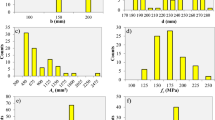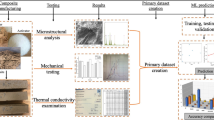Abstract
One of the main causes of structural durability degradation of reinforced concrete structures is corrosion of reinforcing bars. Predicting the bearing capacity of corroded reinforced concrete beams has been examined from experimental and theoretical perspectives. Most of the research works have been done on using individual predicting models instead of exploring the capacity of ensemble models. This study employs various machine-learning models, including support vector regression, artificial neural network, generalized linear regression, classification and regression-based techniques, exhaustive Chi-squared automatic interaction detection, and ensemble inference models to predict the residual capacity of corroded reinforced concrete beams based on actual data. A dataset of 120 samples collected in Ho Chi Minh City, Vietnam, is used for constructing, validating, testing the proposed models. The experimental results and statistical tests show that the generalized linear regression is the best model among all considered single predictive models and the ensemble model of generalized linear regression and artificial neural network obtained the highest prediction performance in estimating residual strength. The contribution to the body of knowledge is the development of ensemble models and various individual models that can predict the residual capacity of corroded reinforced concrete beams in a short time. This study demonstrates an effective prediction application for early structural durability estimation in the planning of building maintenance.




Similar content being viewed by others
References
Liu, J.; Miao, J.; Ba, G.; Xiao, J.; Hou, D.: Effect of stirrup corrosion and fire on shear behavior of reinforced concrete beams. KSCE J. Civ. Eng. 25, 3424–3436 (2021)
Reshvanlou, B.A.; Nasserasadi, K.; Ahmadi, J.: Modified time-dependent model for flexural capacity assessment of corroded RC elements. KSCE J. Civ. Eng. 25, 3897–3910 (2021)
Mailvaganam, N.P.: Repair and Protection of Concrete Structures. CRC Press, London (1991)
Valcuende, M.; Parra, C.: Natural carbonation of self-compacting concretes. Constr. Build. Mater. 24(5), 848–853 (2010)
Ahmad, S.: Reinforcement corrosion in concrete structures, its monitoring and service life prediction––a review. Cement Concr. Compos. 25(4), 459–471 (2003)
Zhou, Y.; Gencturk, B.; Willam, K.; Attar, A.: Carbonation-induced and chloride-induced corrosion in reinforced concrete structures. J. Mater. Civ. Eng. 27(9), 04014245 (2015)
Pargar, F.; Koleva, D.A.; Kolev, H.; van Breugel, K.: The onset of chloride-induced corrosion in reinforced cement-based materials as verified by embeddable chloride sensors. In: Rendon Diaz Miron, L.E.; Koleva, D.A. (Eds.) Concrete Durability: Cementitious Materials and Reinforced Concrete Properties, Behavior and Corrosion Resistance, pp. 23–55. Springer, Cham (2017)
Yang, Y.; Nakamura, H.; Miura, T.; Yamamoto, Y.: Effect of corrosion-induced crack and corroded rebar shape on bond behavior. Struct. Concr. 20(6), 2171–2182 (2019)
Zhou, H.; Lu, J.; Xv, X.; Dong, B.; Xing, F.: Effects of stirrup corrosion on bond–slip performance of reinforcing steel in concrete: an experimental study. Constr. Build. Mater. 93, 257–266 (2015)
Song, L.; Fan, Z.; Hou, J.: Experimental and analytical investigation of the fatigue flexural behavior of corroded reinforced concrete beams. Int. J. Concrete Struct. Mater. 13(1), 24 (2019)
Lachemi, M.; Al-Bayati, N.; Sahmaran, M.; Anil, O.: The effect of corrosion on shear behavior of reinforced self-consolidating concrete beams. Eng. Struct. 79, 1–12 (2014)
Lin, H.; Zhao, Y.: Effects of confinements on the bond strength between concrete and corroded steel bars. Constr. Build. Mater. 118, 127–138 (2016)
El-Sayed, A.K.: Shear capacity assessment of reinforced concrete beams with corroded stirrups. Constr. Build. Mater. 134, 176–184 (2017)
Biswas, R.K.; Iwanami, M.; Chijiwa, N.; Uno, K.: Effect of non-uniform rebar corrosion on structural performance of RC structures: a numerical and experimental investigation. Constr. Build. Mater. 230, 116908 (2020)
Jnaid, F.; Aboutaha, R.S.: Residual flexural strength of corroded reinforced concrete beams. Eng. Struct. 119, 198–216 (2016)
Lu, Z.-H.; Lun, P.-Y.; Li, W.; Luo, Z.; Li, Y.; Liu, P.: Empirical model of corrosion rate for steel reinforced concrete structures in chloride-laden environments. Adv. Struct. Eng. 22(1), 223–239 (2019)
Azad, A.K.; Ahmad, S.; Al-Gohi, B.H.A.: Flexural strength of corroded reinforced concrete beams. Magn. Concr. Res. 62(6), 405–414 (2010)
Lu, Z.-H.; Wang, H.-J.; Qu, F.; Zhao, Y.-G.; Li, P.; Li, W.: Novel empirical model for predicting residual flexural capacity of corroded steel reinforced concrete beam. Front. Struct. Civ. Eng. 14(4), 888–906 (2020)
Lu, Z.-H.; Li, H.; Li, W.; Zhao, Y.-G.; Dong, W.: An empirical model for the shear strength of corroded reinforced concrete beam. Constr. Build. Mater. 188, 1234–1248 (2018)
Liao, S.-H.; Chu, P.-H.; Hsiao, P.-Y.: Data mining techniques and applications—a decade review from 2000 to 2011. Expert Syst. Appl. 39(12), 11303–11311 (2012)
Ahmadi, M.; Naderpour, H.; Kheyroddin, A.: ANN model for predicting the compressive strength of circular steel-confined concrete. Int. J. Civ. Eng. 15(2), 213–221 (2017)
Imam, A.; Kazmi, Z.A.: Modified regression and ANN model for load carrying capacity of corroded reinforced concrete beam. AIMS Mater. Sci. 4(5), 1140–1164 (2020)
Imam, A.; Anifowose, F.; Azad, A.K.: Residual strength of corroded reinforced concrete beams using an adaptive model based on ANN. Int. J. Concr. Struct. Mater. 9(2), 159–172 (2015)
Chou, J.-S.; Pham, T.-P.-T.; Nguyen, T.-K.; Pham, A.-D.; Ngo, N.-T.: Shear strength prediction of reinforced concrete beams by baseline, ensemble, and hybrid machine learning models. Soft. Comput. 24(5), 3393–3411 (2020)
Kou, G.; Yang, P.; Peng, Y.; Xiao, F.; Chen, Y.; Alsaadi, F.E.: Evaluation of feature selection methods for text classification with small datasets using multiple criteria decision-making methods. Appl. Soft Comput. 86, 105836 (2020)
Li, T.; Kou, G.; Peng, Y.; Yu, P.S.: An integrated cluster detection, optimization, and interpretation approach for financial data. IEEE Trans. Cybern. (2021). https://doi.org/10.1109/TCYB.2021.3109066
Kou, G.; Peng, Y.; Wang, G.: Evaluation of clustering algorithms for financial risk analysis using MCDM methods. Inf. Sci. 275, 1–12 (2014)
Li, T.; Kou, G.; Peng, Y.; Shi, Y.: Classifying with adaptive hyper-spheres: an incremental classifier based on competitive learning. IEEE Trans. Syst. Man Cybern. Syst. 50(4), 1218–1229 (2020)
Kou, G.; Lu, Y.; Peng, Y.I.; Shi, Y.: Evaluation of classification algorithms using MCDM and rank correlation. Int. J. Inf. Technol. Decis. Mak. 11(01), 197–225 (2012)
Li, T.; Kou, G.; Peng, Y.: Improving malicious URLs detection via feature engineering: linear and nonlinear space transformation methods. Inf. Syst. 91, 101494 (2020)
Kou, G.; Xiao, H.; Cao, M.; Lee, L.H.: Optimal computing budget allocation for the vector evaluated genetic algorithm in multi-objective simulation optimization. Automatica 129, 109599 (2021)
Chou, J.-S.; Pham, A.-D.: Enhanced artificial intelligence for ensemble approach to predicting high performance concrete compressive strength. Constr. Build. Mater. 49, 554–563 (2013)
Salami, B.A.; Rahman, S.M.; Oyehan, T.A.; Maslehuddin, M.; Al Dulaijan, S.U.: Ensemble machine learning model for corrosion initiation time estimation of embedded steel reinforced self-compacting concrete. Measurement 165, 108141 (2020)
Chou, J.-S.; Ngo, N.-T.; Chong, W.K.: The use of artificial intelligence combiners for modeling steel pitting risk and corrosion rate. Eng. Appl. Artif. Intell. 65, 471–483 (2017)
Cai, R., et al.: Prediction of surface chloride concentration of marine concrete using ensemble machine learning. Cement Concr. Res. 136, 106164 (2020)
Ma, Y.; Guo, Z.; Wang, L.; Zhang, J.: Experimental investigation of corrosion effect on bond behavior between reinforcing bar and concrete. Constr. Build. Mater. 152, 240–249 (2017)
Zhao, Y.; Lin, H.; Wu, K.; Jin, W.: Bond behaviour of normal/recycled concrete and corroded steel bars. Constr. Build. Mater. 48, 348–359 (2013)
Azim, I., et al.: Prediction of catenary action capacity of RC beam-column substructures under a missing column scenario using evolutionary algorithm. KSCE J. Civ. Eng. 25(3), 891–905 (2021)
Li, C.Q.; Yang, S.T.; Saafi, M.: Numerical simulation of behavior of reinforced concrete structures considering corrosion effects on bonding. J. Struct. Eng. 140(12), 04014092 (2014)
Fernandez, I.; Bairán, J.M.; Marí, A.R.: 3D FEM model development from 3D optical measurement technique applied to corroded steel bars. Constr. Build. Mater. 124, 519–532 (2016)
Karthik, M.M.; Mander, J.B.; Hurlebaus, S.: Simulating behaviour of large reinforced concrete beam-column joints subject to ASR/DEF deterioration and influence of corrosion. Eng. Struct. 222, 111064 (2020)
Nguyen, T.-H.; Le, A.-T.; Nguyen, D.-D.: Bending strength diagnosis for corroded reinforced concrete beams with attendance of deterministic, random and fuzzy parameters. J. Struct. Integr. Maint. 5(3), 183–189 (2020)
Al-Osta, M.A.; Al-Sakkaf, H.A.; Sharif, A.M.; Ahmad, S.; Baluch, M.H.: Finite element modeling of corroded RC beams using cohesive surface bonding approach. Comput. Concr. 22(2), 167–182 (2018)
Chakali, Y.; Sadok, A.H.; Tahlaiti, M.; Nacer, T.: A PSO-ANN intelligent hybrid model to predict the compressive strength of limestone fillers roller compacted concrete (RCC) to build dams. KSCE J. Civ. Eng. 25(8), 3008–3018 (2021)
Feng, D.-C., et al.: Machine learning-based compressive strength prediction for concrete: an adaptive boosting approach. Constr. Build. Mater. 230, 117000 (2020)
Fu, B.; Feng, D.-C.: A machine learning-based time-dependent shear strength model for corroded reinforced concrete beams. J. Build. Eng. 36, 102118 (2021)
Amani, J.; Moeini, R.: Prediction of shear strength of reinforced concrete beams using adaptive neuro-fuzzy inference system and artificial neural network. Sci. Iran. 19(2), 242–248 (2012)
Zhang, G., et al.: Reinforced concrete deep beam shear strength capacity modelling using an integrative bio-inspired algorithm with an artificial intelligence model. Eng. Comput. (2020). https://doi.org/10.1007/s00366-020-01137-1
Vapnik, V.N.: The Nature of Statistical Learning Theory. Springer, Berlin (1995)
Breiman, L.; Friedman, J.H.; Richard, A.O.; Stone, C.J.: Classification and Regression Trees. Chapman and Hall/CRC, New York (1984)
Nelder, J.A.; Wedderburn, R.W.M.: Generalized linear models. J. R. Stat. Soc. Ser. A (Gen.) 135(3), 370–384 (1972)
Kass, G.V.: "An exploratory technique for investigating large quantities of categorical data. J. R. Stat. Soc. Ser. C (Appl. Stat.) 29(2), 119–127 (1980)
Sut, N.; Simsek, O.: Comparison of regression tree data mining methods for prediction of mortality in head injury. Expert Syst. Appl. 38(12), 15534–15539 (2011)
Vietnamese standard: Loads and Actions norm for design, 1995.
Kohavi, R.: A study of cross-validation and bootstrap for accuracy estimation and model selection. Presented at the Proceedings of the 14th International Joint Conference on Artificial Intelligence—vol. 2, Montreal, QC, Canada (1995)
Chou, J.-S.; Bui, D.-K.: Modeling heating and cooling loads by artificial intelligence for energy-efficient building design. Energy Build. 82, 437–446 (2014)
S. Inc: PASW Statistics for Windows, ed. Chicago: SPSS Inc (2018)
Ngo, N.-T.; Pham, A.-D.; Truong, T.T.H.; Truong, N.-S.; Huynh, N.-T.; Pham, T.M.: An ensemble machine learning model for enhancing the prediction accuracy of energy consumption in buildings. Arab. J. Sci. Eng. (2021). https://doi.org/10.1007/s13369-021-05927-7
Özdemir, E.: A new predictive model for uniaxial compressive strength of rock using machine learning method: artificial intelligence-based age-layered population structure genetic programming (ALPS-GP). Arab. J. Sci. Eng. (2021). https://doi.org/10.1007/s13369-021-05761-x
Torabi-Kaveh, M.; Sarshari, B.: Predicting convergence rate of namaklan twin tunnels using machine learning methods. Arab. J. Sci. Eng. 45(5), 3761–3780 (2020)
Cheng, M.-Y.; Cao, M.-T.: Accurately predicting building energy performance using evolutionary multivariate adaptive regression splines. Appl. Soft Comput. 22, 178–188 (2014)
Acknowledgements
This work belongs to the project grant No: T2021-98TĐ funded by Ho Chi Minh City University of Technology and Education, Vietnam.
Author information
Authors and Affiliations
Corresponding author
Appendix: Supplementary Data
Rights and permissions
About this article
Cite this article
Nguyen, TH., Nguyen, DT., Nguyen, DH. et al. Evaluation of Residual Strength of Corroded Reinforced Concrete Beams Using Machine Learning Models. Arab J Sci Eng 47, 9985–10002 (2022). https://doi.org/10.1007/s13369-021-06493-8
Received:
Accepted:
Published:
Issue Date:
DOI: https://doi.org/10.1007/s13369-021-06493-8




